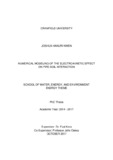JavaScript is disabled for your browser. Some features of this site may not work without it.
| dc.contributor.advisor | Kara, Fuat | |
| dc.contributor.advisor | Oakey, John | |
| dc.contributor.author | Joshua, Hakuri Nwen | |
| dc.date.accessioned | 2022-08-31T12:35:27Z | |
| dc.date.available | 2022-08-31T12:35:27Z | |
| dc.date.issued | 2017-10 | |
| dc.identifier.uri | https://dspace.lib.cranfield.ac.uk/handle/1826/18383 | |
| dc.description.abstract | The high pressure and high temperature (HP/HT) of operating fluid and soft soil content significantly account for the axial and lateral displacement of subsea pipelines. The ability of a pipeline to resist displacement depends on the soil strength. Due to low soil shear strength, the accumulation of displacement over a period of operating cycles leads to pipeline displacement. Increasing the pipe-soil interaction resistance will significantly reduce pipeline displacement. Soil contains solid, water and air particles. The levels of water, air and the solid particle size in the soil, govern its mechanical behaviour. Removal of pore water content from the soil voids may lead to consolidation with a resultant increase in effective stress. One of the methods used to increase soil strength is the Electro-Kinetic (EK) process. This is applied to increase the strength of onshore and offshore soil foundations. An important advantage is a reduction in time taken for the soil to consolidate. A Numerical model is developed for the determination of the EK effect on soft soil using the ABAQUS software tool. Two stages involved in the EK analyses are electro-osmotic consolidation and dynamic pipe-soil interaction. Three different test series each for electro-osmotic consolidation and dynamic analyses were built. The electro-osmotic consolidation analyses determined the soil consolidation followed by a dynamic pipe-soil interaction process. The electro-osmosis considered the effect of voltage variations, time taking for the soil to consolidate and variations with numbers of electrodes. The dynamic analyses consider the effect of electro-osmosis due to the displacement of pipeline in the vertical, axial, and lateral direction. From the electro-osmotic analyses, the soil settlement is due to its reduction in void volume as a result of the pore water pressure dissipation. A further interaction of pipeline on the (settled) consolidated soil indicates a significant improvement in the soil strength when compared with the non-treated soil. | en_UK |
| dc.language.iso | en | en_UK |
| dc.rights | © Cranfield University, 2015. All rights reserved. No part of this publication may be reproduced without the written permission of the copyright holder. | |
| dc.subject | soil | en_UK |
| dc.subject | content | en_UK |
| dc.subject | high pressure | en_UK |
| dc.subject | high temperature | en_UK |
| dc.subject | accumulation | en_UK |
| dc.subject | displacement | en_UK |
| dc.subject | electro-kinetic | en_UK |
| dc.subject | ABAQUS | en_UK |
| dc.subject | electro-osmotic | en_UK |
| dc.title | Numerical modelling of the electro-kinetic effect on pipe-soil interaction. | en_UK |
| dc.type | Thesis | en_UK |
| dc.description.coursename | PhD in Energy and Power | en_UK |
